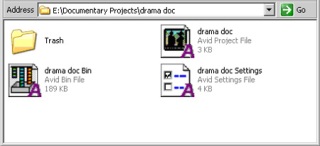The work you do on an Avid project can be the culmination of a lot of hard work and time. Imagine how you might feel if one day you opened your Avid project and all the media had gone or it just refused to open. Perhaps someone deleted your work, the project had corrupted or the hard disk failed. All these are possibilities but they are possibilities that you can guard against by following a few simple rules.
1. Always make a backup copy of your Avid project when you have finished working. For MA IJ Documentary students the project folder can be found in the Documentary Projects folder on the hard drive. Your project folder will be named as it is when you open it in Avid. Inside your project folder you will find files ending with .avb, .avp and .avs. These are the important files that make your project work.
Close the Avid application and then Copy your project folder (and its contents) to either the Avid Project Backup folder on the D drive or F drive. If you save it on the D drive you will need to remember which computer you used last.
The project folder is very small in size so will on take a few seconds to copy. If the project folder already exists where you are trying to save it, you should overwrite it with the newer, latest version.
2. Always name your tapes, first by sticking a label with a name onto the tape and second by naming the tape during the capture process.
When the camera is recognised by the capture tool the Select Tape window opens. Click New Tape and enter the name for the tape. The tape name must correspond to that written on the label.
The next time you capture from that tape, the name will be listed in the Select Tape window. Select the correct tape name to begin the capture process.
3. Never record over your tapes until you are sure the project is complete, marked and if necessary exported.
If the captured media is lost, the only way to retrieve it may be from the tapes. If you have recorded over footage you have captured, then it is lost forever.
However, if you followed step 2 and 3 then the footage can be Batch Captured from the tapes by using the information stored in the project files.
Following these simple rules will mean that if an Avid project is lost or corrupted, it can be restored within minutes from a backup. And if the media is lost or corrupted it can be re-captured relatively quickly and easily.


